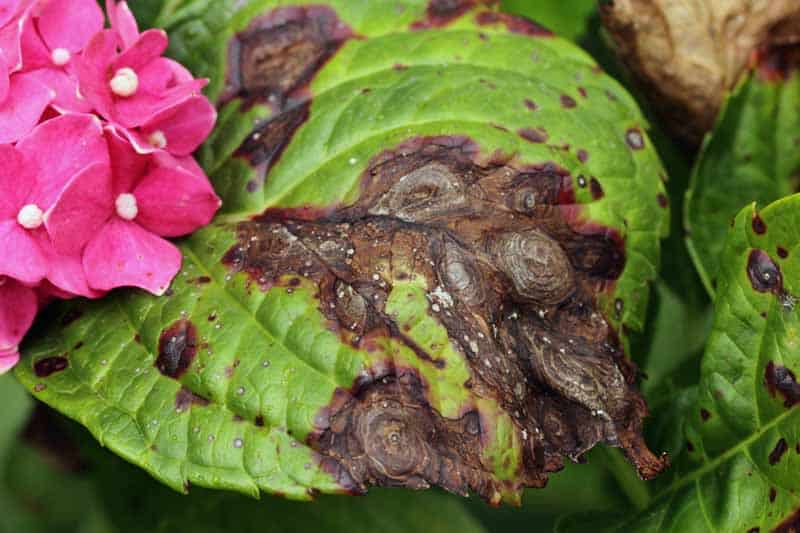
How to treat hydrangea diseases. Few things are more lovely than luxuriant hydrangea plants. Unfortunately, a variety of fungi and viruses can impair their appearance (and two bacterial diseases).
You may take precautions to prevent one of these diseases from affecting your beautiful plants, though.
In order for you to know what to look for and how to prevent and treat them, we will introduce you to the main hydrangea illnesses in this post.
Botrytis Blight (Botrytis cinerea)
The flower buds may even be fatally affected by this fungus before they bloom. Infected flower parts might also fall to the ground and infect the foliage.
Water-soaked patches on the blooms are one of the first indications. But they develop into sores that are reddish brown.
Botrytis is more prone to causing issues in chilly, moist environments, such as several days of gloomy, muggy weather.
You can attempt to stop this illness by taking certain actions. To minimize the humidity, To avoid getting the flowers and foliage wet, avoid watering late in the day and just at the roots.
Keep your plants well-ventilated if you can. Pruning should be done on tightly spaced branches after correct spacing. As you prune, clean your pruning shears with bleach to prevent unintentionally spreading any illness.
Additionally, eliminate any dead or damaged flowers and foliage to stop the fungus from entering the plant. So that Botrytis cannot survive on the dead tissue, clear the area around the plant of trash.
Fungicides can be required if your issue persists. Iprodione and thiophanate-methyl are alternatives.
Leaf Spots (Cercospora species and Phyllosticta hydrangea)
On the base of the plant, cercospora appears as round purple or brown patches. The leaves may turn yellow and drop off the plant as the diseases grow.
These illnesses may be avoided by watering the lawn without soaking the leaves. You can use liquid kelp, hydrogen peroxide, garlic oil, compost tea, or other remedies if your hydrangeas do become sick.
The fungicides chlorothalonil and thiophanate-methyl are further options.
This widespread fungal infection is more likely to affect plants that have received a lot of fertilizer.
The conditions that favor infection are created by persistent rain or dense fog.
On the leaves or blossoms, the fungus causes huge brown dots that lighten in hue toward the center. One identifying indication is the angular development of dots around the veins.
Additionally, you can cure this condition with liquid kelp, hydrogen peroxide, garlic oil, or compost tea.
Powdery Mildew (Erysiphe polygoni)
On the surface of the leaves, powdery mildew appears as a white, powdery material. The underside of the leaves is covered with a white, cottony growth.
If the fungus is not controlled, it may infect the growing buds and impede their growth.
When the days are warm and the nights are chilly, powdery mildew is most likely to affect hydrangeas.
By lowering humidity and raising air circulation, the sickness can be avoided.
Applying a fungicide as soon as you find the illness is one approach to managing it. Utilizing neem is an additional choice.
Rust (Pucciniastrum hydrangea)
Hydrangea rust requires two hosts to thrive, yet it doesn’t harm either of them, unlike other rusts. Only the smooth hydrangea, H. arborescens, and hemlock serve as hosts for this rust.
Orange pustules and yellow dots on the tops of the hydrangea leaves are the first signs of the disease.
Although this illness is challenging to treat, you can do so by clearing the area surrounding both hosts of any contaminated leaves and other debris that may have fallen to the ground. Make care to clean your pruning shears before thinning the hydrangea’s inside.
Grow the cultivar “Frosty” if you anticipate having rust issues because it is resistant to this ailment.
Bacterial Diseases
Blight in the leaves and flower clusters is the initial symptom of this significant bacterial disease. Worse infestations, however, can bring in both root rot and wilting.
In warmer conditions and during periods of heavy rain, bacterial wilt mostly develops. The sickness cannot be controlled chemically.
The bacteria that cause this illness can enter the plant through wounds or other naturally occurring holes like stomata.
Water-soaked areas are one of the first signs. The blotches get angular and darker. The leaves may die if these patches develop into bigger lesions.
If you have a susceptible plant, you can protect it with copper hydroxide (Kocide).
Conclusion
Although hydrangeas are tough and resilient plants, both novice and expert gardeners have had problems with hydrangea diseases.
Fortunately for all of us, the majority of hydrangea infections we come across may be easily treated without causing any damage to your beautiful shrubs.

